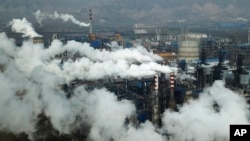On July 27, China’s state-run newspaper Global Times criticized Canada’s handling of its wildfires, which the paper said caused “immeasurable” damage to the global environment.
Canada is suffering from the worst fire season on record, with some 4,797 fires active as of July 26, 132% of its 10-year average rates.
The Global Times said Canadian authorities have failed to prevent and extinguish the wildfires, allowing the issue to become a global environmental emergency. The paper then praised China’s effectiveness in handling forest fires and used related data to paint an image of an ecologically responsible country.
“According to estimation, the average annual emission of carbon dioxide caused by forest fires in China from 2000-2021 was approximately 15 million tons, only account for 0.2 percent of the global forest fire emissions, demonstrating China's responsible role as a major country.”
That claim is misleading.
The use of data showing the wildfires’ low CO2 emissions is an attempt to whitewash China’s role as a top global polluter and is not indicative of its overall devastating impact on climate change.
The World Bank reported that in 2022, China emitted 27% of global carbon dioxide and a third of the world’s greenhouse gases. The United States came next with 14%, and India was third with 8%.
“Without China successfully transitioning to a low-carbon economy, achieving global climate goals will be impossible,” the World Bank said.
The main reason for China topping the list of the world’s largest CO2 emitters is its reliance on coal.
In 2021, Chinese President Xi Jinping pledged to strictly control coal and begin cutting its use starting in 2026 and thereby bring China’s CO2 emissions to a peak before 2030.
However, in 2022, China failed to meet high energy demands caused by extreme weather, which led to widespread power shortages. Since then, China has pushed to approve more coal power to address the problems with power capacity.
That trend has continued this year. The environmental group Greenpeace reported that local governments in China approved 20.45 gigawatts of new coal power in the first three months of 2023, up from 8.6GW in the same period of 2022. In 2021, a total of 18GW of coal was approved in China.
“Continuing to throw coal at the inefficiencies in China’s energy system is a dead end,” Greenpeace said. “And it risks climate disasters, financial burden and locking us into a high-carbon pathway.”
Other environmental groups argue that China’s overall effort to battle climate change is insufficient. Climate Action Tracker, a project funded by foundations and governments worldwide that tracks progress toward reaching Paris Agreement goals, rates China’s overall effort to battle climate change and control greenhouse gas emissions as “highly insufficient.”
It is important to note that forest fires are just one component of overall carbon dioxide emissions, and their impact is relatively small compared to human activities, such as fossil fuel use — the burning of coal, natural gas and petroleum.
Western scientists see wildfires as a natural part of the ecosystem, meaning wildfires are usually left to burn if they are not having an impact on human lives or property. In China, local authorities will usually send firefighters to put out any fire, even if it’s happening in a very remote place.
As a result, the CO2 emissions caused by forest fires in China are significantly lower than in other countries.
While Polygraph.info could not verify Global Times’ assertion that forest fires in China account for only 0.2% of global forest fire emissions, James MacCarthy, a research associate with Global Forest Watch, an open-source web application to monitor global forests in near real-time, told Polygraph.info that the newspaper’s estimate seems plausible.
Using GFW’s data on global tree cover loss due to fires for 2001-2022, MacCarthy found that during that period, China lost about 945,000 hectares of tree cover to fires, compared to a total of 126,000,000 hectares of tree cover lost due to fires globally.
“That would mean China accounted for about 0.75 percent of global tree cover loss due to fire from 2001 to 2022. Assuming there is some difference in the definition of what constitutes a forest, and depending on whether they are looking at estimates of aboveground/belowground carbon emissions, their estimate seems reasonable,” MacCarthy said.
While the Global Times’ number is reasonable, that itself does not demonstrate “China's responsible role as a major country,” as the publication claimed.
Carbon dioxide is the gas most responsible for global warming. It has the ability to trap solar radiation and thereby cause the temperature of Earth’s atmosphere to rise.
At the same time, China is also investing heavily into renewable energy. According to BloombergNEF, China has invested heavily in clean and renewable energy, spending about $546 billion in 2022 on solar and wind energy, electric vehicles and batteries.
In the same year, the U.S. invested $141 billion. The European Union, viewed as a single bloc, spent $180 billion on energy transition.







